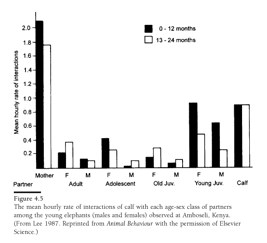Elephants
& Siesmic Communication
Stuart Steidle & Sara Post ~ Reed Bio 342
| Home | Phylogeny | Ontogeny | Mechanism | AdaptiveValue | References | CourseHome |
Where does the ability to communicate seismically originate?
Life timeline:
Young elephants are precocious: they can stand within a few hours of birth and feed themselves with grass through their trunks within a month.
Though calves are nursed and nurtured for an extremely long time compared to other mammals, after a few months, the calves begin to wander away from their mothers during the daytime. As they age and travel a great distance from their parent, their method of communication becomes more developed in order to locate the parent. Vijayakumarau Nair, researcher of Asian elephant ontogeny in Bandilur India, observed that calves first vocalize with loud bellows and later learn to communicate seismically after some years. Asian elephants are known to bang their trunks to the ground in the following contexts (O’Connell-Rodwell, Hart and Arnason, 2001):
- After the birth of a calf (females)
- When a musth bull joins the heard
- In threatening an intruder
- Assessment of stability of certain pathways
Fig1. The mean hourly rate of interactions of various age groupings of elephants (males and females) observed in Kenya. (R. Sukuma)
The figure shows that the majority of calls are done by the mother signaling to her young; as elephants age they become more independent, signaling less when not during mating season. However, the rate of calling depends also on the presense of a threat, atmospheric conditions, and other environmental factors.
Researcher R. Sukuma hypothesized that the elephant’s ability to communicate seismically is not surprising because small animals (ex. bats) perceive higher frequencies than human range, and in contrast the large elephants perceive and send lower frequency signals.
